- Visibility 353 Views
- Downloads 30 Downloads
- Permissions
- DOI 10.18231/j.ijced.2021.038
-
CrossMark
- Citation
The impact of superficial dermatophytosis on quality of life: A cross-sectional observational study
- Author Details:
-
Horatti Laxmi
-
Kumar Dilip N R *
Abstract
Background: The Indian dermatologists are witnessing an epidemic of sorts when it comes to superficial dermatophytosis cases in the last decade. At the receiving end of this epidemic are the patients who are suffering due to impaired quality of life. We tried to assess the impact of tinea on quality of life (QoL) of the patients.
Aim: To assess the impact of superficial dermatosis on quality of life using the Dermatology Life Quality Index (DLQI) questionnaire.
Settings and Design: Cross-sectional, Observational study.
Material and Methods: All patients between the age group of 18 to 70 years presenting with superficial dermatophytosis of more than 3 weeks duration were included after confirming the diagnosis with KOH mount. The patients filled in the DLQI after which scores were calculated and the effect on QoL was assessed.
Results: Out of the 170 patients included in the study, majority of them (77, 45.3%) felt that tinea had a very large effect on their QoL and a very few patients (7, 4.1%) felt that tinea had a small effect on their QoL. Out of the 36 (21.2%) patients who felt that their condition had an extremely large effect on their QoL, majority of the patients had tinea corporis et cruris et faciei.
Conclusion: Superficial dermatophytosis has a very large effect on the Quality of Life of the patients and it impacts their lives adversely leading to psychological, social and financial problems.
Introduction
In the last few years, we have noticed a huge surge of cases of superficial dermatophytosis almost to an epidemic proportion in India.[1] It is one of the commonest dermatoses seen in any dermatologist’s practice. In various parts of the country, recurrent, recalcitrant and resistant dermatophytosis are increasing at an alarming rate. The factors leading to the increase of these type of cases are use and abuse of topical steroid preparations, poor personal hygiene, irrational use of antifungal agents, etc.[2] The expert consensus statement ECTODERM India published in 2018 provides guidelines for care, management and decision making to help manage such cases.[3] While most of dermatologists are more alert and focused on handling the changed scenarios of dermatophytosis, the patients’ quality of life (QoL) is usually not paid enough attention to. There is no doubt that superficial dermatophytosis causes a lot of social embarrassment and stress which in turn affects their QoL, but the same has not been fully assessed and understood by the dermatologists. The authors of the article have also come across patients with suicidal tendencies due to recalcitrant tinea. This sense of immense psychological impact led us to assess the QoL in patients of dermatophytosis to identify the magnitude of impact.
Materials and Methods
Our study was a cross-sectional observational study conducted over a period of 3 months from January to March 2021 at our Dermatology OPD. All patients between the age group of 18 to 70 years presenting with superficial dermatophytosis of more than 3 weeks duration were included after confirming the diagnosis with KOH mount. Informed consent was taken from all the patients willing to participate in the study and they were included regardless of the treatment status of dermatophytosis. Patients with any other co-existing dermatoses, comorbidities such as diabetes mellitus, hypertension, dyslipidemias, psychiatric conditions and pregnant women were not included in the study to avoid confounding bias.
After taking informed consent, demographic details were noted down in a proforma and detailed clinical examination was done, following which, the Dermatology Life Quality Index (DLQI) questionnaire (in English/Kannada) first published by Finlay et al[4] was given to all the patients. Assistance was provided illiterate patients to score the questionnaire. After the scoring of each question was done, the questionnaire forms were collected and summed to obtain a DLQI score.
DLQI scoring: DLQI included 10 questions to which patients indicated their response ranging from 0 to 3 points for every question and the total sum of score ranged from 0 to 30 points. The effect on QOL was assessed based on the total score as 0–1 (no effect), 2–5 (small effect), 6–10 (moderate effect), 11–20 (very large effect), and 21–30 (extremely large effect).
Results
One hundred and seventy patients were recruited into the study, including 112 (65.9%) males and 58 (34.1%) females. The patients included were in the age group of 19-70 years with a mean of 36.5 years and standard deviation 11.92 years, with 121 (71.2%) patients in the age group of 18-40 years and 49 (28.8%) patients in the age group of 40-70 years. Most of the patients 98(57.6%) had 6-12 weeks duration of symptoms, followed by more than 12 weeks duration in 65 (38.2%) patients and only 7 (4.1%) patients had a less than 6 weeks duration of symptoms. Seventy patients (41.2%) had a prior history of self-medication with topical steroids and native medications. A history of tinea in close contacts was found in 129 (75.9%) patients [[Table 1]].
The commonest presentation in our study was Tinea corporis ([Figure 1], [Figure 2]) in 61 (35.9%) patients, closely followed by Tinea corporis et cruris ([Figure 3]), in 59 (34.7%) patients. The patients presenting with tinea faciei ([Figure 4]), manuum ([Figure 5]) and pedis were very low, 5 (2.9%), 4 (2.4%), 4 (2.4%) respectively [[Table 2]].
The body surface area (BSA) of involvement was more than 10% in 138 (81.2%) patients and less than 10% in the remaining 32 (18.8%) patients. According to the DLQI questionnaire, scoring was done and assessed. Majority of the patients (77, 45.3%) felt that tinea had a very large effect on their QoL and a very few patients (7, 4.1%) felt that tinea had a small effect on their QoL [[Table 3]].
Out of the 36 (21.2%) patients who felt that their condition had an extremely large effect on their QoL, majority of the patients had tinea corporis et cruris et faciei [[Table 4]]. The mean and standard deviation of DLQI scores is tabulated in [[Table 5]].
|
Variable |
Number of Patients (n=170) |
Percentage (%) |
|
Age group |
|
|
|
18-40 |
121 |
71.2 |
|
40-70 |
49 |
28.8 |
|
Sex |
|
|
|
Male |
112 |
65.9 |
|
Female |
58 |
34.1 |
|
Duration of symptoms |
|
|
|
<6 weeks |
7 |
4.1 |
|
6-12 weeks |
98 |
57.6 |
|
>12 weeks |
65 |
38.2 |
|
Treatment taken before |
|
|
|
Yes |
107 |
62.9 |
|
No |
63 |
37.1 |
|
Self medication |
|
|
|
Yes |
70 |
41.2 |
|
No |
100 |
58.8 |
|
Steriod cream application |
|
|
|
Yes |
70 |
41.2 |
|
No |
100 |
58.8 |
|
H/o tinea in close contact |
|
|
|
Yes |
129 |
75.9 |
|
No |
41 |
24.1 |
|
|
Number of patients (n=170) |
Percentage (%) |
|
Corporis |
61 |
35.9 |
|
Corporis and cruris |
59 |
34.7 |
|
Corporis, cruris and faciei |
17 |
10.0 |
|
Corporis, cruris, faciei and pedis |
1 |
.6 |
|
Cruris |
19 |
11.2 |
|
Faciei |
5 |
2.9 |
|
Manuum |
4 |
2.4 |
|
Pedis |
4 |
2.4 |
|
DQLI Grading |
Number of patients |
Percentage (%) |
|
Small effect |
7 |
4.1 |
|
Moderate effect |
50 |
29.4 |
|
Very large effect |
77 |
45.3 |
|
Extremely Large Effect |
36 |
21.2 |
|
Type of tinea infection |
Dqli |
||||
|
Small effect |
Moderate effect |
Very large effect |
Extremely large effect |
Total |
|
|
T corporis |
2 |
31 |
21 (27.3) |
7 (19.4) |
61 (35.9) |
|
Corporis and cruris |
0 |
7 |
46 (59.7) |
6 (16.7) |
59(34.7) |
|
Corporis, cruris and faciei |
0 |
0 |
1 (1.3) |
16 (44.4) |
17 (10.0) |
|
Corporis, cruris, faciei and pedis |
0 |
0 |
0 |
1 (2.8) |
1 (6.0) |
|
T cruris |
2 |
11 |
5 (6.5) |
1(2.8) |
19 (11.2) |
|
T faciei |
0 |
0 |
0 |
5(13.9) |
5 (2.9) |
|
Manuum |
0 |
0 |
4 (5.2) |
0 |
4 (2.4) |
|
Pedis |
3 |
1 |
0 |
0 |
4 (2.4) |
|
Total |
7 |
50 |
770) |
36 (100) |
170 (100) |
|
Type of tinea infection |
Number (n=170) |
DLQI |
|
|
Mean |
SD |
||
|
Corporis |
61 |
11.92 |
5.142 |
|
Corporis and cruris |
59 |
15.51 |
4.083 |
|
Corporis, cruris and faciei |
17 |
22.12 |
2.342 |
|
Corporis, cruris, faciei and pedis |
1 |
26.00 |
- |
|
Cruris |
19 |
9.95 |
4.020 |
|
Faciei |
5 |
23.00 |
1.225 |
|
Manuum |
4 |
14.75 |
3.096 |
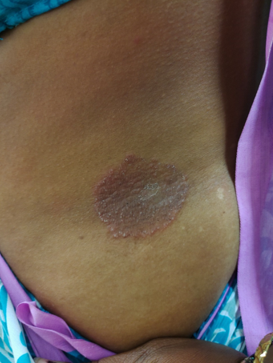
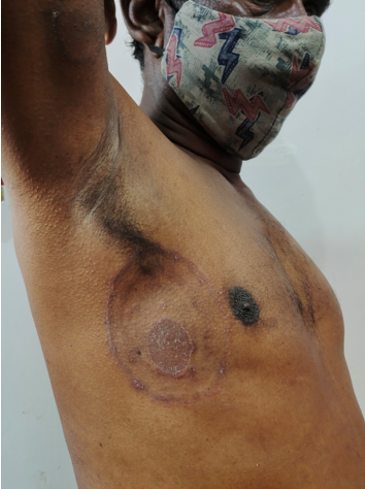
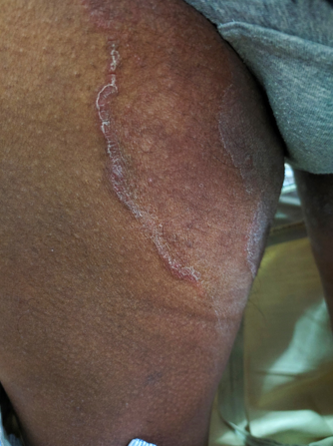
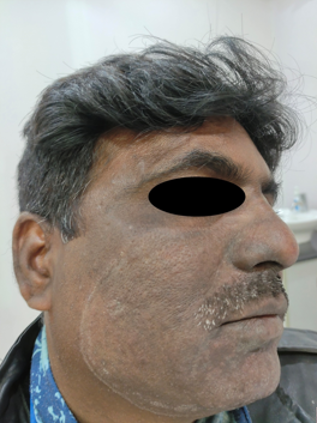
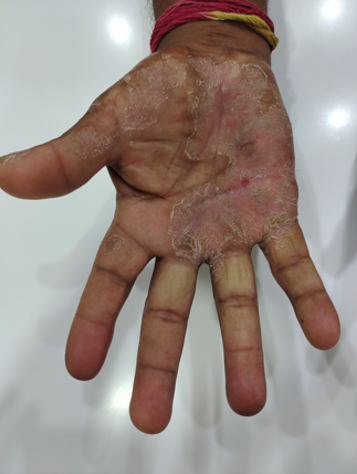
Discussion
Dermatophytosis is caused by a group of fungi called dermatophytes which thrive on keratinized tissues (skin, hair, nail).[5] Tinea is the commonest superficial fungal infection. Based on the affected site, clinically various types of tinea can be seen such as: tinea capitis (head), tinea faciei (face), tinea barbae (beard), tinea corporis (body), tinea manuum (hand), tinea cruris (groin), tinea pedis (foot), and tinea unguium (nail). Few atypical variants include steroid modified tinea, tinea imbricata, tinea pseudoimbricata, and majocchi granuloma.
Trichophyton rubrum is the commonest causative organism of superficial dermatophytosis in India.[6] Over the last decade most of the dermatologists in India are facing a flurry of Dermatophytosis patients, most of them being chronic, relapsing, recurrent, recalcitrant and severe disease. The expert consensus ECTODERM India by Rajagopal et al[3] has defined chronic dermatophytosis as disease for more than 6 months to 1 year, with or without recurrence, in spite of being adequately treated; relapsing dermatophytosis as occurrence of dermatophytosis (lesions), after a longer period of infection-free interval (6–8 weeks) in a patient who has been cured clinically; recurrent dermatophytosis as re-occurrence of the disease (lesions) within few weeks (< 6 weeks) after completion of the treatment; severe disease as involvement of more than 10% BSA by the dermatophytosis lesions.
The plight of patients suffering from such a severely itchy condition is unimaginable. It affects their sleep, personal life, work life as well as social life. In general, QoL is the patient’s sense of well-being in various domains of life such as physical health, psychological status, sexual well-being, financial status, occupation and social interaction.[7] The presence of long standing, severe, relapsing itchy condition definitely affects these domains governing the QoL; also, the tinea lesions may sometimes be present in the visible body areas causing social stigma. Itching is the predominant symptom seen in dermatophytosis and is the major factor leading to reduced QoL. The next major factor is the area of involvement; for instance, tinea faciei can lead social embarrassment due to appearance of lesions over the face. Other important factors identified are the financial expenses incurred to treat dermatophytosis, difficulty in application of topical creams over large body areas, inability to attend social gatherings for fear of stigma, lack of sleep etc.
The DLQI questionnaire is designed for use in adults (i.e. patients over 16 years). It is self-explanatory and can be simply handed to the patients without the need for detailed explanations. The questions in the DLQI are classified into 6 heading items: symptoms and feelings (questions 1 and 2), daily activities (questions 3 and 4), leisure (questions 5 and 6) and personal relationships (questions 8 and 9), each item with a maximum score of 6, work and school (question 7) and treatment (question 10), each item with a maximum score of 3 (table1 ). The DLQI is calculated by summing up the scores of each question resulting in a maximum of 30 and a minimum of 0. The higher the score, the more the QoL is impaired [30]. The DLQI questionnaire has been translated into 55 languages and extensively validated.
The DLQI questionnaire is self-explanatory and designed for use in adults. The 10 questions in the DLQI are grouped into 6 headings: symptoms and feelings (questions 1 and 2), daily activities (questions 3 and 4), leisure (questions 5 and 6) and personal relationships (questions 8 and 9), each item with a maximum score of 6, work and school (question 7) and treatment (question 10), each item with a maximum score of 3 [Table 5]. The DLQI is calculated by adding the scores of each question with a maximum of 30 and a minimum of 0. The higher the score, the more the QoL is impaired.[8]
The lowest score of DLQI in our study was 4 and the maximum was 26. This essentially means that there was no patient whose scores suggested that the disease had no effect (scores 0 to 1) on QoL. DLQI had a mean of 14.28 with a standard deviation of 5.783. Most of the patients’ scores (77, 45.3%) ranged between 11 to 20 indicating that tinea has a very large effect on QoL. Out of the 77 patients whose DLQI scores were between 11 to 20, 46 patients had tinea corporis et cruris. The second largest group (50, 29.4%) of patients’ scores was 6 to 10 indicating moderate effect on QoL, out of which the maximum patients (31) had isolated tinea corporis. The group of patients with scores between 21 to 30, classified as having extremely large effect on QoL included 36 (21.2%) patients, out of which the majority patients (16) had tinea corporis et cruris et faciei. The last group of patients with scores between 2 to 5, classified as having a small effect on QoL was seen in only 7(4.1%) patients of which 3 patients had tinea pedis and 2 each of tinea corporis and tinea cruris. Only 5 patients in the study had isolated tinea faciei and all of these patients’ scores were in the extremely large effect group indicating the large effect of social stigma in relation to QoL.
Conclusion
There is absolutely no doubt that superficial dermatophytosis affects the physical wellbeing, mental status and adds to the financial burden of the patients. The high DLQI scores in these patients points out that the superficial dermatophytosis has a very large effect on the Quality of Life of the patients and it impacts their lives adversely leading to psychological, social and financial problems. It is essential that we take this aspect into consideration while treating superficial dermatosis.
Conflict of Interest
The authors declare that there are no conflicts of interest in this paper.
Source of Funding
None.
References
- Panda S, Verma S. The menace of dermatophytosis in India: The evidence that we need. Indian J Dermatol Venereol Leprol. 2017;83:281-4. [Google Scholar] [Crossref]
- Verma S, Madhu R. The great Indian epidemic of superficial dermatophytosis: An appraisal. Indian J Dermatol. 2017;62(3):227-36. [Google Scholar]
- Rajagopalan M, Inamadar A, Mittal A, Miskeen AK, Srinivas CR, Sardana K. Expert Consensus on The Management of Dermatophytosis in India (ECTODERM India). BMC Dermatol. 2018;18(1). [Google Scholar]
- Finlay AY, Khan GK. Dermatology Life Quality Index (DLQI)--a simple practical measure for routine clinical use. Clin Exp Dermatol. 1994;19(3):210-6. [Google Scholar]
- Weitzman I, Summerbell RC. The dermatophytes. Clin Microbiol Rev. 1995;8(2):240-59. [Google Scholar] [Crossref]
- Sahoo AK, Mahajan R. Management of tinea corporis, tinea cruris, and tinea pedis: A comprehensive review. Indian Dermatol Online J. 2016;7(2):77-86. [Google Scholar] [Crossref]
- Guyatt GH, Feeny DH, Patrick DL. Measuring health-related quality of life. Ann Intern Med. 1993;118(8):622-9. [Google Scholar] [Crossref]
- Ingordo V, Cazzaniga S, Medri M, Raone B, Digiuseppe MD, Musumeci ML. To what extent is quality of life impaired in vitiligo? A multicenter study on Italian patients using the dermatology life quality index. Dermatology. 2014;229(3):240-7. [Google Scholar]
How to Cite This Article
Vancouver
Laxmi H, R KDN. The impact of superficial dermatophytosis on quality of life: A cross-sectional observational study [Internet]. IP Indian J Clin Exp Dermatol. 2021 [cited 2025 Oct 09];7(3):191-196. Available from: https://doi.org/10.18231/j.ijced.2021.038
APA
Laxmi, H., R, K. D. N. (2021). The impact of superficial dermatophytosis on quality of life: A cross-sectional observational study. IP Indian J Clin Exp Dermatol, 7(3), 191-196. https://doi.org/10.18231/j.ijced.2021.038
MLA
Laxmi, Horatti, R, Kumar Dilip N. "The impact of superficial dermatophytosis on quality of life: A cross-sectional observational study." IP Indian J Clin Exp Dermatol, vol. 7, no. 3, 2021, pp. 191-196. https://doi.org/10.18231/j.ijced.2021.038
Chicago
Laxmi, H., R, K. D. N.. "The impact of superficial dermatophytosis on quality of life: A cross-sectional observational study." IP Indian J Clin Exp Dermatol 7, no. 3 (2021): 191-196. https://doi.org/10.18231/j.ijced.2021.038
